Hassani S. Mathematical Physics: A Modern Introduction to Its Foundations
Подождите немного. Документ загружается.

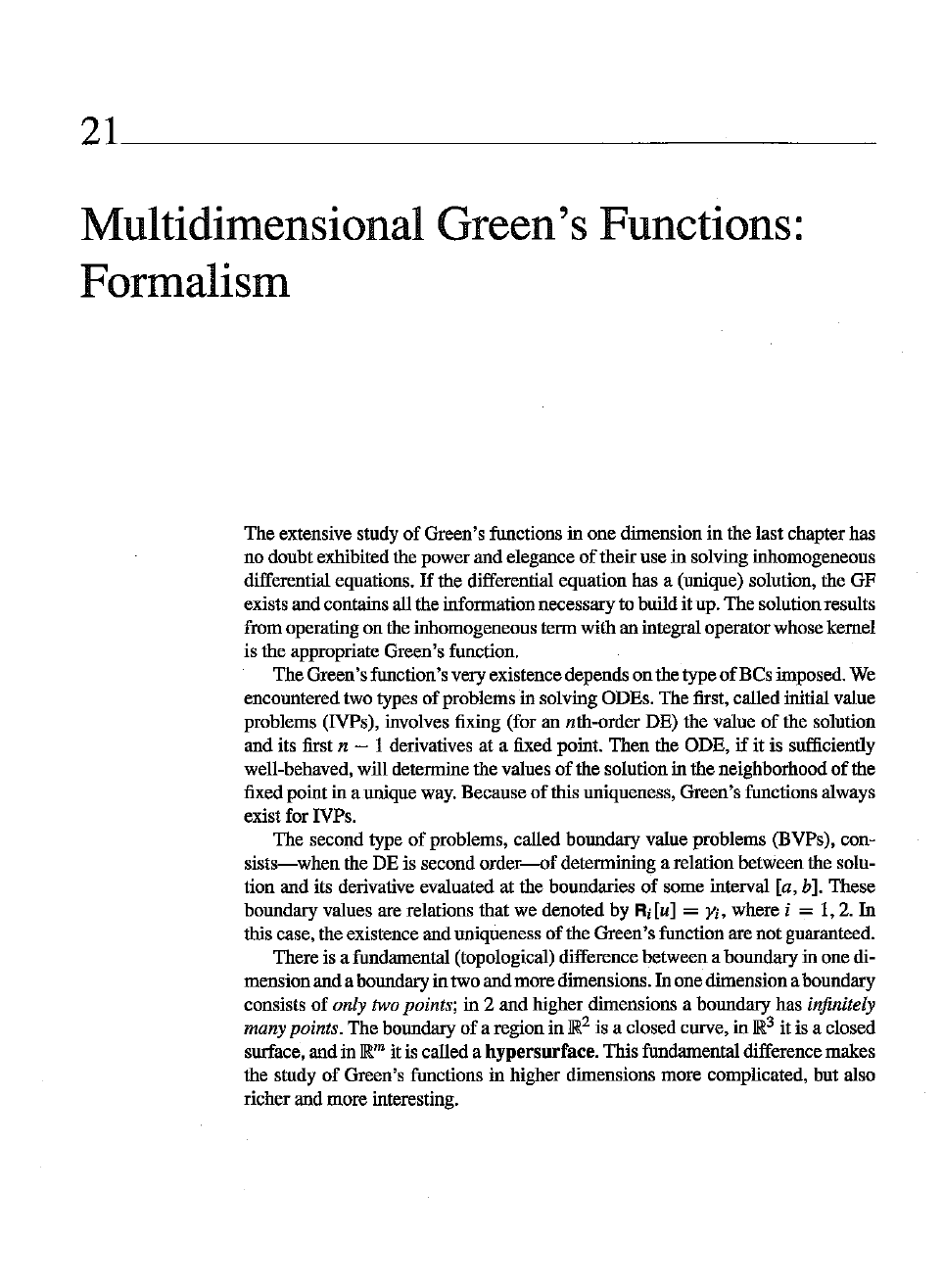
21 _
Multidimensional Green's Functions:
Formalism
The
extensive study
of
Green's functions in
one
dimension in the last chapterhas
no doubt exhibited the power
and
elegance
of
their use in solving inhomogeneous
differential equations.
If
the differential equation has a (unique) solution, the GF
exists
and
contains all the informationnecessaryto build it up.
The
solutionresults
from operating on the inhomogeneous term
with
an integraloperatorwhosekernel
is the
appropriate
Green'sfunction.
The
Green'sfunction's very existencedepends on the type
ofBCs
imposed. We
encounteredtwo types
of
problems in solving ODEs. The first, called initial value
problems
(NPs),
involves fixing (for an nth-order DE) the value
of
the solution
and its first
n - I derivatives at a fixed point.
Then
the ODE,
if
it is sufficiently
well-behaved, will determine the values
of
the solution in the neighborhood
of
the
fixedpointina unique
way.
Becauseof thisuniqueness,
Green's
functions
always
exist for IVPs.
The
second type
of
problems, called boundary value problems (BVPs), con-
sists-when
the DE is second
order-of
determining a relationbetween the solu-
tion and its derivative evaluated at the boundaries
of
some interval [a, b]. These
boundary values are relations that we denoted by
Ri[U] = Yi, where i =
1,2.
In
this case, the existence and uniqueness
of
the
Green's
function are
not
guaranteed.
There is a fundamental (topological) difference betweena boundaryin one di-
mension
and
a boundaryin two
and
more
dimensions.Inone dimensiona boundary
consists
of
only two points; in 2
and
higher dimensions a boundary has infinitely
many points.
The boundary
of
a region in jR2 is a closed curve, in jR3 it is a closed
surface,
and
in jRm it is called a
hypersurface.
Thisfundamental differencemakes
the study
of
Green's functions in higher dimensions
more
complicated, but also
richer and more interesting.
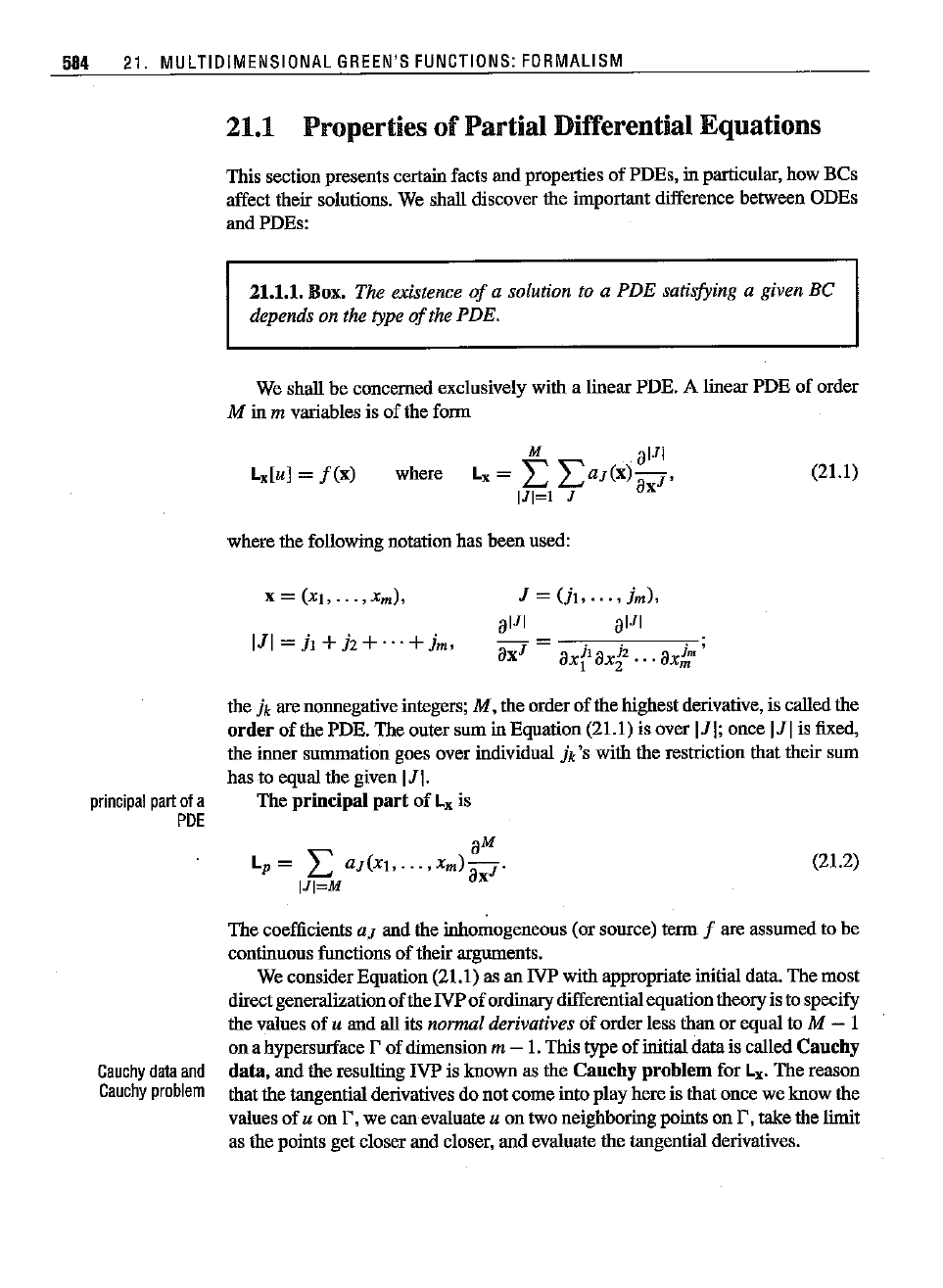
584 21. MULTIDIMENSIONAL
GREEN'S
FUNCTIONS:
FORMALISM
21.1 Properties
of
Partial Differential Equations
This section presents certain facts and properties of POEs, in particular, how BCs
affect their solutions. We shall discover the important difference between OOEs
andPOEs:
21.1.1. Box. The existence
of
a solution to a
PDE
satisfying a given Be
depends on the type
of
the PDE.
We shall be concerned exclusively with a linear POE. A linear POE of order
M in m variables is of the form
Lxlu]
=
f(x)
where (21.1)
where the following notation has been used:
x =
(Xl,
...
, X
m
) ,
IJI = h +Iz+...+i«.
J=(h,
..
·,jm),
alJI a
lJI
=
ax!
axil
ax4
2
••.
ax!:'
'
the ikare nonnegativeintegers;
M,
the orderof the highest derivative, is called the
order
of the POE. The outer sum in Equation (21.1) is over IJI;once IJIis fixed,
the
inner
summation
goes over
individual
A'8 withthe
restriction
that
their
sum
has to equal the given IJ
I.
principal
part
ofa The
principal
part
of Lxis
POE
(21.2)
Cauchy
data
and
Cauchy
problem
The coefficients aj and the inhomogeneous (or source) term f are assumed to be
contiouous functions of their arguments.
We considerEquation (21.1) as an
NP
with appropriate initial data. The most
direct generalizationofthe
IVP
of
ordinarydifferentialequationtheory is to specify
the values of
u and all its normal derivatives
of
order less than or equal to M - 1
on a hypersurface
r of dimensionm - 1.This type of initialdatais called
Cauchy
data,
and the resulting
IVP
is known as the
Cauchy
problem
for
Lx.
The reason
that the tangential derivatives do not comeinto playhere is that once we know the
values of
u on r, we can evaluate u on two neighboring points on
I',
take the limit
as the points get closer and closer, and evaluate the tangential derivatives.

(21.3)
21.1
PROPERTIES
OF
PARTIAL
DIFFERENTIAL
EQUATIONS
585
21.1.1 Characteristic Hypersurfaces
In contrast to the IVP in one dimension, the Cauchy problemfor arbitrary Caucby
data
maynothaveasolution, or
if
it does,thesolutionmaynotbe
unique.
21.1.2. Box. The existence and uniqueness
of
the solution
of
the Cauchy
problem dependcrucially on the hypersurface r and on the type
of
PDE.
We assumethat r can be parametrizedby a set of m functions
of
m- 1parameters.
These parameters can be thought of as generalized coordinates of points
of
r.
Consider a point P on r. Introduce m - 1 coordinates
~2,
...
,
~m,
called
tangential
tangential
coordinates, to label points on r. Choose, by translation if necessary,
coordinates
coordinates in such a way that P is the origin, with coordinates (0, 0,
...
,0).
Now
let
v =
~l
stand for the remaining coordinate normal to r.Usually
~i
is taken to be
the
lth
coordinate of the projection of the point on r onto the hyperplane tangent
to
F'
at
P.
As long as we do not move too far away from P, the Cauchy data on r can be
written
as
au
aM-lu
u(O,
~2,
...
,
~m),
av(0,
~2,
...
,
~m),
...
, av
M
-
1
(0,
~2,
...
,
~m).
Using the chainrule,
au/ax,
=
L:7~1
(au/a~j
)(a~j
/aXi),
where
~l
= v, we can
also determine the first
M
-·1
derivatives
of
u withrespect to Xi. The fundamental
question is whether we
can
determine u uniquely using the above Cauchy data
and the DE. To motivate the answer, let's look at the analogous problem in one
dimension.
Consider the Mth-orderlinear ODE
dMu du
Lx[u] =
aM(x)
dx
M
+...+
al(x)
dx +ao(x)u =
f(x)
with the following initial data at xo: {u(xo), u'(xo),
...
,u(M-I)(xO)}.
If
the co-
efficients
{ak(x)}~o
and the inhomogeneous term
f(x)
are continuous and
if
au
(xo)
i'
0, then Theorem 20.2.3 implies that there exists a unique solution to
the
IVP
in a neighborhood
of
xo.
For
aM(xo)
i'
0, Equation (21.3), the initial data, and a knowledge of
f(xo)
give U(M)(xo) uniquely. Having found u(M)(xO), we can calculate, with arbitrary
accuracy (by choosing Ax small enough), the following set of
new initial data at
Xl =
Xo
+
Ax:
U(XI) = u(xo) +
u'(xo)AX,
...
,
u(M-I)(XI)
= u(M-I)(xO) +U(M)
(xo)Ax.
Using these new initial data and Theorem 20.2.3, we are assured of a unique
solution
atxl.
Since au
(x)
is assumedto be continuousfor Xl, for sufficiently small
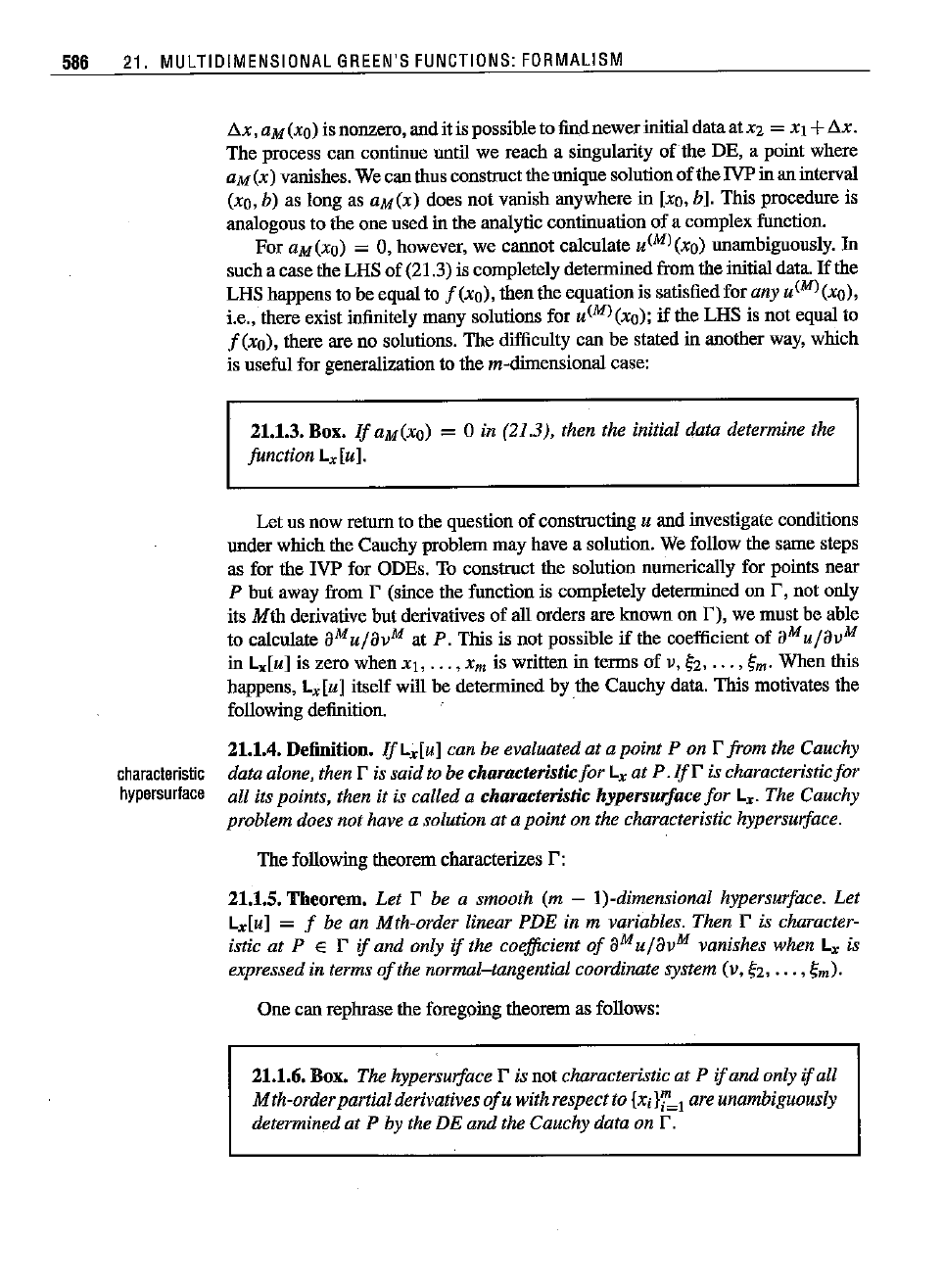
586
21. MULTIDIMENSIONAL
GREEN'S
FUNCTIONS:
FORMALISM
Sx,
aM(xo) is nonzero, and it is possibleto find newerinitial data at X2 = Xl +
L\.x.
The process
can
continue until we reach a singularity
of
the DE, a point where
aM(x) vanishes. We can thus constructthe unique solution
of
theIVP in an interval
(xo, b) as long as aM(x) does not vanish anywhere in [xo,b]. This procedure is
analogous to the one used in the analytic continuation of a complex function.
For
aM(xO) = 0, however, we cannot calculate u(M)(xO) unambiguously. In
such a case the LHS of (21.3) is completelydetermined from the initial data.
If
the
LHS happens to be equal to
f(xo),
then the equation is satisfied for any
U(M)
(xo),
i.e., there exist infinitely many solutions for
U(M)
(xo);
if
the LHS is not equal to
f (xo), there are no solutions. The difficulty can be stated in another way, which
is useful for generalization to the m-dimensional case:
21.1.3. Box.
If
au(xo) = 0 in (21.3), then the initial data determine the
function Lx[uj.
characteristic
hypersurface
Let
us now return to the question
of
constructing u and investigate conditions
under which the Cauchy problem may have a solution. We follow the same steps
as for the
IVP
for ODEs. To construct the solution numerically for points near
P but away from r (since the function is completely determined on r, not ouly
its
Mth
derivative but derivatives of all orders are known on I"), we mustbe able
to calculate
aM
ujav
M
at P. This is not possible
if
the coefficient of aM
ujav
M
in
Lx[u]
is zerowhen
Xl,
•••
, X
m
is
written
in
terms
of v,
~2,
'"
,~m.
Whenthis
happens, Lx[uj itself will be determined by the Cauchy data. This motivates the
following definition.
21.1.4. Definition.
IfLx[uj can be evaluated at a point P on r from the Cauchy
data alone, then
r is said to be churacteristicfor Lxat P.
Ifr
is characteristicfor
all its points, then
it is called a characteristic hypersurfacefor
Lx.
The Cauchy
problem does not have a solution at a point on the characteristic hypersurface.
The following theorem characterizes I':
21.1.5.
Theorem.
Let r be a smooth (m - I)-dimensional hypersurface. Let
Lx[u]
= f be an Mth-order linear PDE in m variables. Then r is character-
istic at
PEr
ifand only if the coefficient
of
aM
ujav
M
vanishes when
Lx is
expressed in terms
of
the normal-tangential coordinate system (v,
~2,
...
,
~m).
One can rephrase the foregoing theorem as follows:
21.1.6. Box. The hypersurface r is not characteristic at P if
and
only ifall
Mth-orderpartialderivatives
ofu
with respect to [xili=l are unambiguously
determined at P by the DE and the Cauchy data on
r.
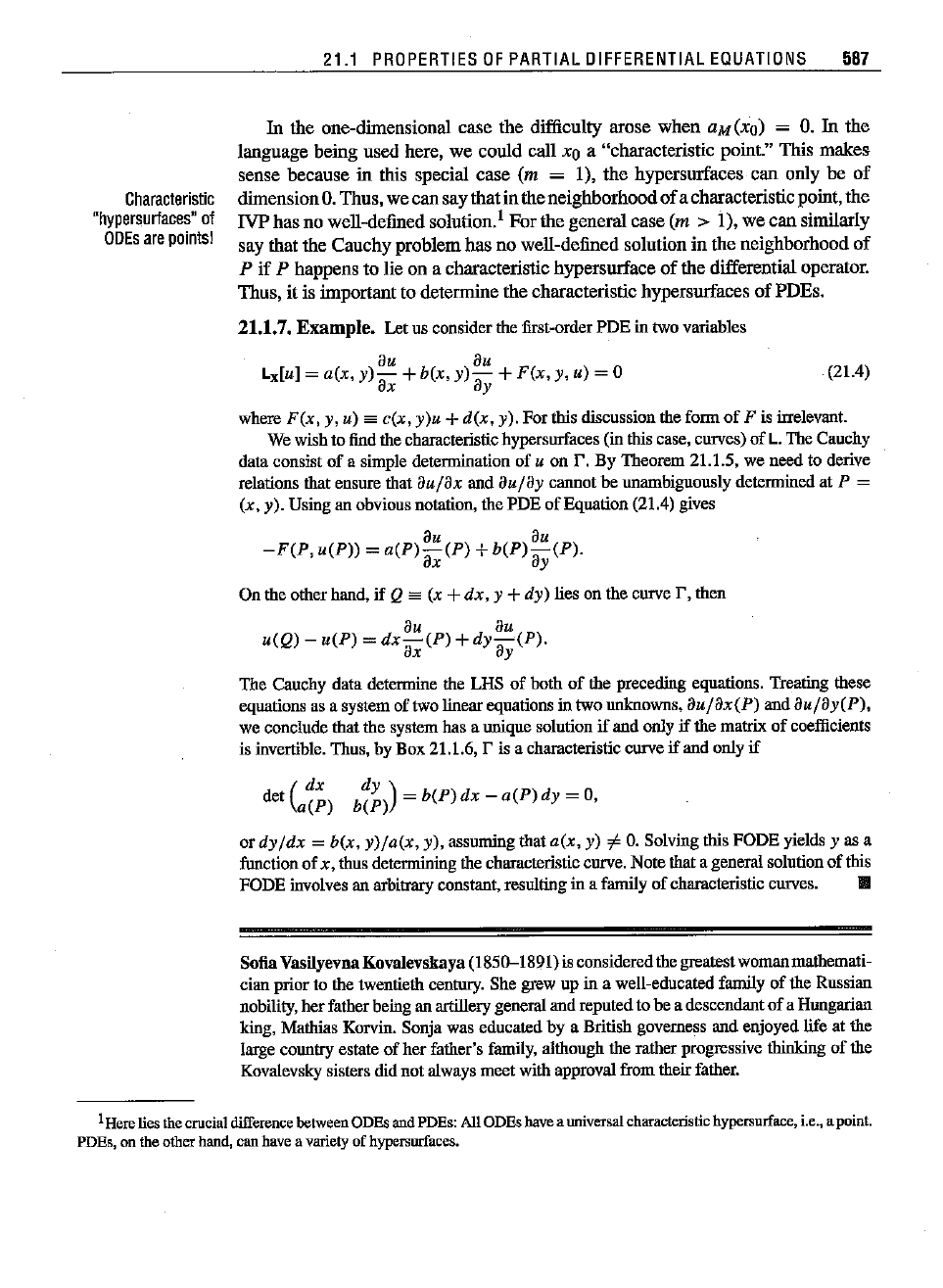
(21.4)
Characteristic
"hypersurtaces"
of
ODEs
are
points!
21.1 PROPERTIES OF
PARTIAL
OIFFERENTIAL
EQUATIONS
587
In
the
one-dimensional case the difficulty arose
when
aM(xO) =
O.
In
the
language being used here, we
could
call
xo
a "characteristic point." This
makes
sense because in this special case (m =
I),
the
hypersurfaces
can
ouly be
of
dimensionO.Thus,we
can
say thatin the
neighborhood
of
a characteristicpoint,
the
IVP
has
no well-defined solution.I For the general case (m > I), we
can
similarly
say that the
Cauchy
problem
bas
no well-defined solution in the neighborhood
of
P
if
P happens to lie on a characteristic hypersurface
of
the differential operator.
Thus, it is important to determine
the
characteristic hypersurfaces
of
PDEs.
21.1.7.
Example.
Lei us considerthe first-orderPDE in twovariables
au au
Lx[u] =
a(x,
y)-
+ hex,
y)-
+
F(x,
y, u) = 0
ax ay
where F (x, y, u)
==
c(x,
y)u
+d(x, y). For thisdiscussion theform of F is irrelevant.
Wewishto
find
the
characteristic
hypersurfaces
(in thiscase,
curves)
of L. The
Cauchy
data
consistof a simple
determination
of u on r. By
Theorem
21.1.5, we needto
derive
relations
that
ensure
that
au/ax
and
8uj8y
cannot
be
unambiguously
determined
at P =
(x, y). Usingan obviousnotation,the PDE of Equation (21.4) gives
au au
-F(P,
u(P))
=
a(P)-(P)
+
b(P)-a
(P).
ax y
On the oiher band, if Q es (x +
dx,
y +dy) lies on the curve F, then
au
au
u(Q)
-
u(P)
=
dx-(P)
+dy~(P).
ax ay
The
Cauchy
data
determine
the LHSof bothof the
preceding
equations.
Treating
these
equationsas a systemoftwo linearequationsin twonnknowns,
au/ax(p)
and
au/ay(p),
we
conclude
that
thesystemhasa
unique
solution if andonlyif the
matrix
of coefficients
is
invertible.
Thus,
byBox 21.1.6,
I'
is a
characteristic
curve
if
andonly
if
(
dx
det
alP)
dy )
b(P)
=
b(P)
dx
-
alP)
dy = 0,
or
dy/dx
=hex,
y)/a(x,
y), assaming ihat
a(x,
y) #
O.
Solvingthis
FaDE
yields y as a
function
of x,
thus
determining
the
characteristic
curve.
Note
that
a
general
solution
ofthis
FODEinvolves an
arbitrary
constant,
resulting
inafamilyof
characteristic
curves.
III
SofiaVasilyevnaKovalevskaya (1850--1891) isconsideredthegreatestwomanmaihemati-
ciao
prior
to the
twentieth
century.
Shegrewupin a well-educated familyof the
Russian
nobility,
her
father
beingan
artillery
general
and
reputed
tobea
descendant
of a
Hungarian
king,
Mathias
Kervin.
Sonja
was
educated
by a
British
governess
and
enjoyed
life atthe
large
country
estate
of her
father's
family,
although
the
rather
progressive
thinking
of the
Kovalevsky
sisters
didnot
always
meetwith
approval
from
their
father.
1Hereliesthe
crucial
difference
betweenODEsand
PDEs:
AllODEshavea
universal
characteristic
hypersurface, i.e., apoint.
PDEs,on theother
hand,
canhavea
variety
of
hypersurfaces.
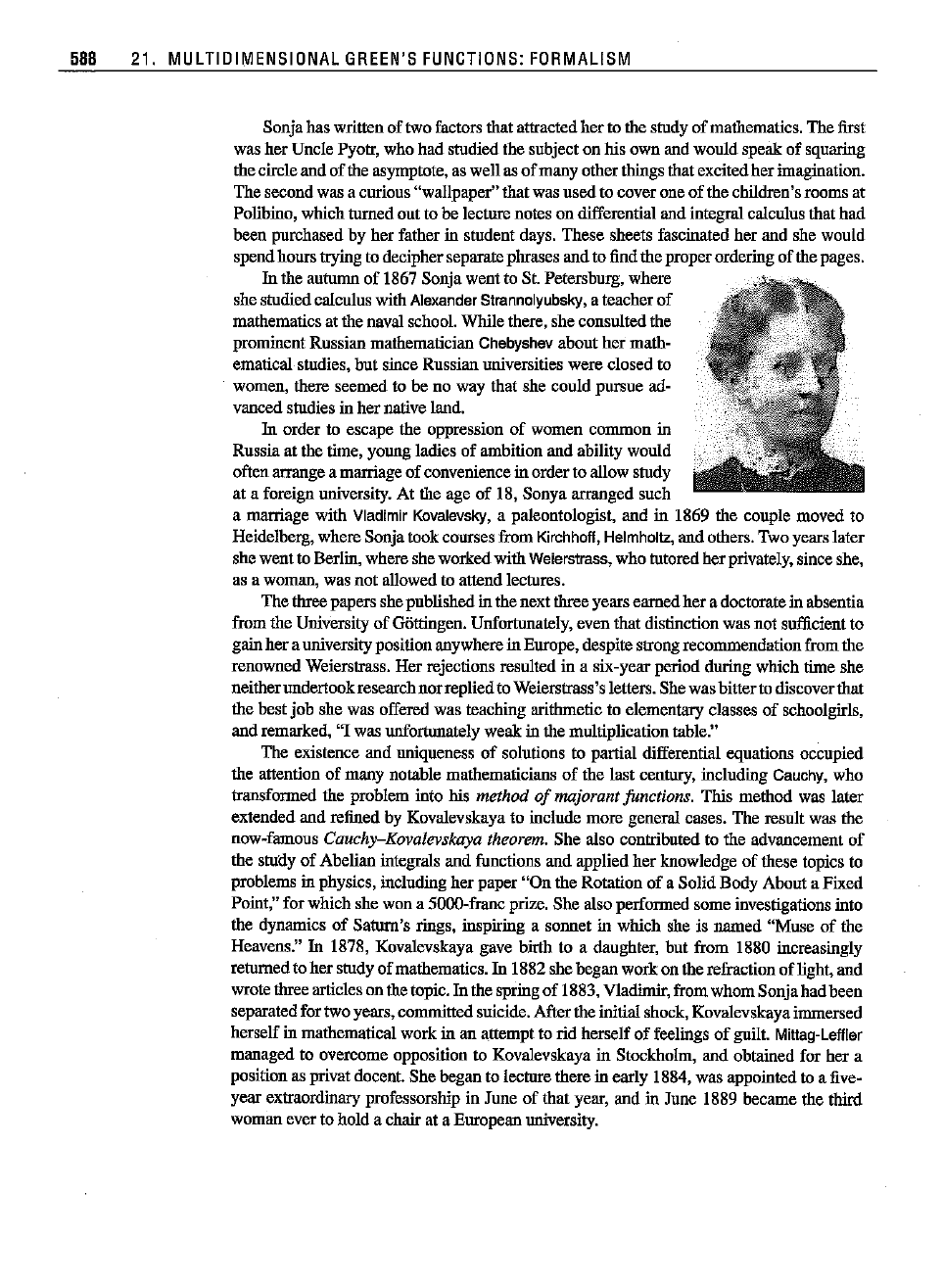
588
21. MULTIOIMENSIONAL
GREEN'S
FUNCTIONS:
FORMALISM
Sonja has written oftwo factors that attracted her to the study of mathematics. The first
was her Uncle Pyotr, who had studied the subject on his own and would speak of squaring
thecircleandoftheasymptote, aswellasofmanyotherthingsthatexcitedherimagination.
The second was a curious "wallpaper"that was used to cover one of the children's rooms at
Polibino, which turned out to be lecture notes on differential and integral calculus that had
been purchased by her father in student days. These sheets fascinated her and she would
spendhourstryingtodecipherseparatephrasesandtofindtheproperorderingofthepages.
In the autumn of 1867 Sonja went to St. Petersburg, where
she studied calculus with
Alexander
Strannolyubsky, a teacher of
mathematics at the navalschool.While there, she consulted the
prominent Russian mathematician Chebyshevabout her math-
ematicalstudies, but since Russian universities were closed to
women, there seemed to be no way that she could pursue ad-
vanced studies in her native land.
In order to escape the oppression of women common in
Russia at the time, young ladies of ambition and ability would
often arrange a marriage of convenience
in order to allow study
at a foreign university. At the age of 18, Sonya arranged such
a marriage with
Vladimir
Kovalevsky,
a paleontologist, and in 1869 the couple moved to
Heidelberg, where Sonja took courses from
Kirchhoff,
Helmholtz,
and others. Twoyears later
shewent to Berlin, where she worked with Weierstrass,who tutored her privately,since she,
as a woman, was not allowed to attend lectures.
The threepapers shepublished in thenext three years earned her adoctorate in absentia
from the University of G5ttingen. Unfortunately, even that distinction was not sufficientto
gain her a universityposition anywhere in Europe, despite strongrecommendation from the
renowned Weierstrass. Her rejections resulted in a six-year period during which time she
neitherundertook research norreplied toWeierstrass's letters. She wasbitter todiscoverthat
the best job she was offered was teaching arithmetic to elementary classes of schoolgirls,
and remarked, "I was unfortunately weak in the multiplication table."
The existence and uniqueness of solutions to partial differential equations occupied
the attention of many notable mathematicians of the last century, including Cauchy,who
transformed the problem into his method
of
majorant functions. This method was later
extended and refined by Kovalevskaya to include more general cases. The result was the
now-famous Cauchy-Kovalevskaya theorem. She also contributed to the advancement of
the studyof Abelianintegralsand functionsand appliedher knowledgeof these topicsto
problems in physics, including her paper
"On
the Rotation of a Solid Body About a Fixed
Point,"for which she won a 5000-franc prize. She also performed some investigationsinto
the dynamics of Saturn's rings, inspiring a sonnet in which she is named "Muse of the
Heavens."
In 1878, Kovalevskaya gave birth to a daughter, but from 1880 increasingly
returned toher study of mathematics. h11882 she began work on therefraction of light, and
wrotethree articleson thetopic.In the springof 1883,Vladimir,from whom Sonjahad been
separated for two years, committed suicide. After the initial shock,Kovalevskayaimmersed
herself in mathematical work in an attempt to rid herselfof feelings
of
guilt.
MiUag-Leffler
managed to overcome opposition to Kovalevskaya in Stockholm, and obtained for her a
position as privatdocent. She began to lecture there in early 1884, was appointed to a five-
year extraordinary professorship in June of that year, and
in June 1889 became the third
woman ever to hold a chair at a European university.
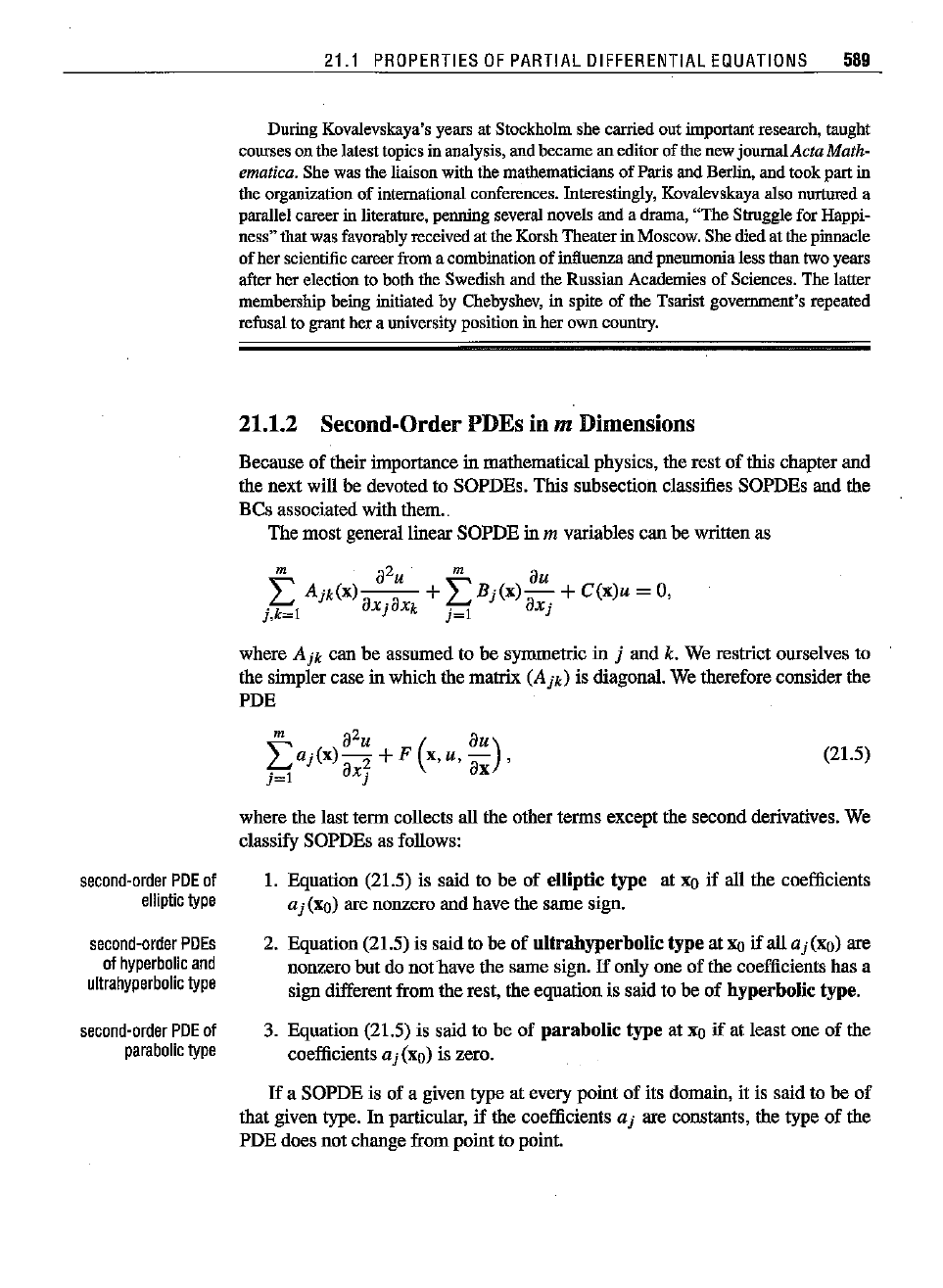
21.1
PROPERTIES
OF
PARTIAL OIFFERENTIAL
EQUATIONS
589
During Kovalevskaya's years at Stockholm she carried out important research, taught
courses on the latesttopics in analysis, and
became
an editorof the new joumalActaMath-
ematica.
She was the liaison with the mathematicians
of
Paris and Berlin. and took part in
the organization
of
international conferences. Interestingly, Kovalevskaya also nurtured a
parallel career
in literature, penning several novels and a drama,
"The
Struggle for Happi-
ness"that was favorably received at the KarshTheater
in Moscow. She died at the pinnacle
ofherscientific careerfromacombination ofinfluenza andpneumonialessthantwoyears
after her election to both the Swedish and the Russian Academies
of
Sciences. The latter
membership being initiated
by Chebyshev, in spite
of
the Tsarist government's repeated
refusal to grant her a university position in her own country.
21.1.2 Second-Order PDEs in m Dimensions
Because of their importance in mathematical physics, the rest
of
this chapter and
the next will be devoted to SOPDEs. This subsection classifies SOPDEs and the
Bes
associated with them..
The most general linear SOPDE in
m variables
can
be written as
where
A
jk
can be assumed to be symmetric in j and k. We restrict ourselves to
the simpler case in which the matrix
(A
jk)
is diagonal. We therefore consider the
PDE
(21.5)
second-order
POE
of
elliptic
type
second-order
POEs
of
hyperbolic
and
ullrahyperbolic
type
second-order
POE
of
parabolic
type
where the last term collects all the other terms except the second derivatives. We
classify SOPDEs as follows:
1. Equation (21.5) is said to be of elliptic
type
at
xo
if all the coefficients
aj (xo) are nonzero and have the same sign.
2. Equation (21.5) is said to be
of
ultrahyperbolic
type
at
xo
if
all a
j(xo)
are
nonzero but do not have the same sign.
If
only one of the coefficients has a
sign different from the rest, the equation is said to be of
hyperbolic
type.
3. Equation (21.5) is said to be of
parabolic
type
at
xo
if
at least one of the
coefficients
aj (xo) is zero.
If
a SOPDE is of a given type at every point of its domain, it is said to be of
that given type. In particular,
if
the coefficients aj are constants, the type
of
the
PDE does not change from point to point.
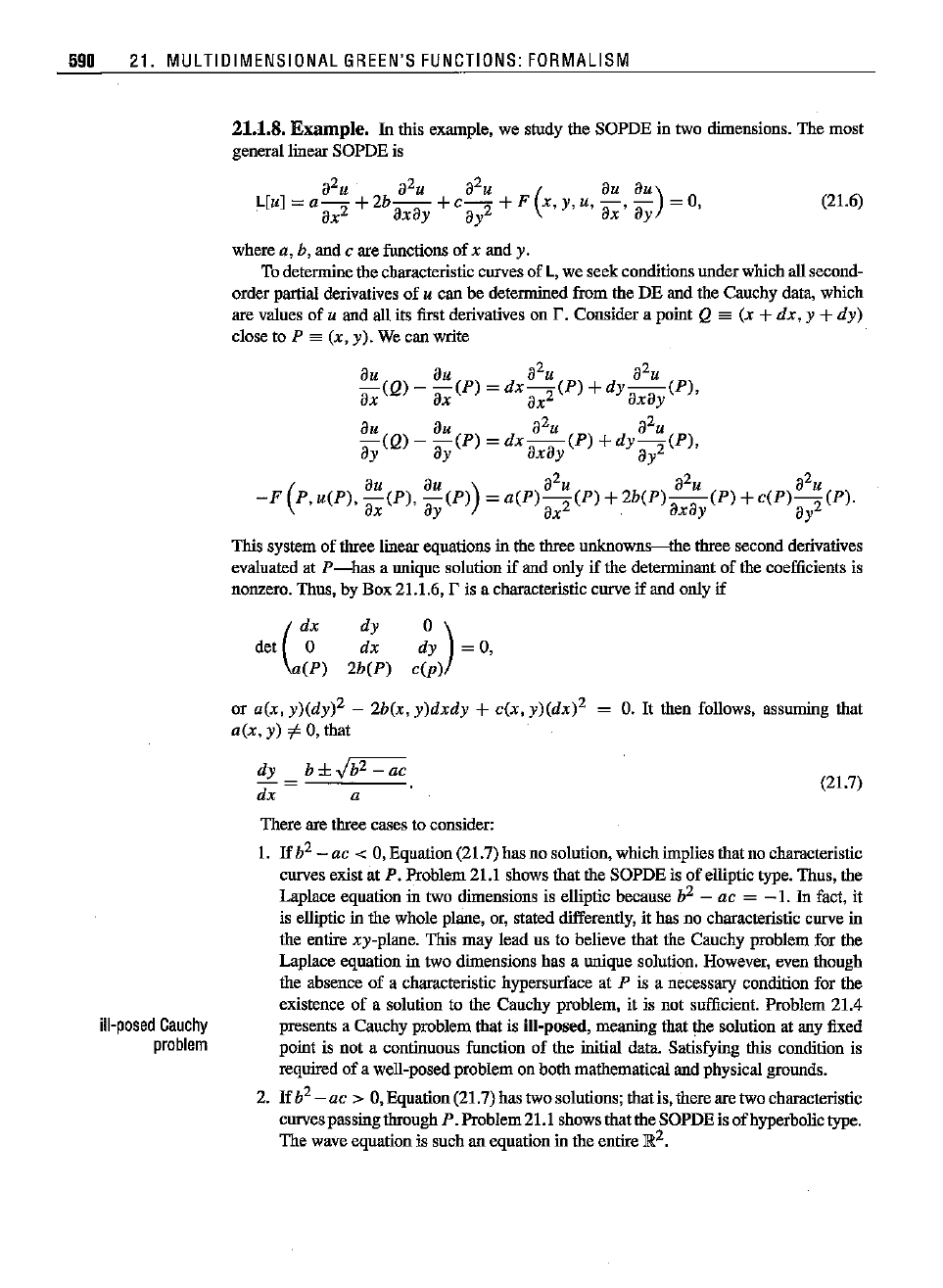
(21.6)
590 21. MULTIDIMENSIONAL
GREEN'S
FUNCTIONS:
FORMALISM
21.1.8.
Example.
In
this example, we study the SOPDE in two dimensions.The most
generallinear SOPDEis
a
2
u a
2
u a
2
u (
au
au)
L[u]=a
2+2b--+c
2+F
x,y,u,;-,;-
=0,
ax
axay
ay
ox oy
where a, b,and c are functions
of
x and y.
To determinethe characteristic curves of L,we seekconditions
under
which allsecond-
order partial derivatives
of
u can be determined from the
DE
and the Cauchy data, which
are values
of
u and all its first derivatives on
I',
Consider a point Q
==
(x +
dx,
y +
dy)
close to P
==
(x, y). Wecanwrite
au au aZu aZu
-(Q)
-
-(P)
=
dx-
z
(PH
dy-(P),
ax ax ax
axay
au au aZu aZu
-(Q)
-
-(P)
=
dx-(P)
+
dy-(P),
ay
ay
axay
ayz
(
au
au)
a
2u
a
2u
a
2u
-F
P,
u(P),
-(P),
-(P)
=
a(P)2(P)
+
2b(P)""(P)
+c(P)2(P),
ax
ay
ax
oxoy
ay
This system
of
three linear equations in the three
unknowns-the
three second derivatives
evaluated at
P-has
a unique solution
if
and only
if
the determinant
of
the coefficients is
nonzero.Thus, by Box21.1.6,
I'
is a characteristiccurve if andonly
if
(
dx
det 0
alP)
dy
dx
2b(P)
~y)
=0,
c(p)
or a(x,
y)(dy)z
- 2b(x,
y)dxdy
+ c(x,
y)(dx)z
a(x,
y) "" 0, that
dy
b±~
dx
a
O.
It
then follows, assuming that
(21.7)
ill-posed
Cauchy
problem
There are three cases to consider:
1.
If
b
2
-ac
< 0, Equation (21.7) hasno solution, which implies that no characteristic
curves exist at
P. Problem 21.1 shows that the SOPDE is of elliptic type. Thus, the
Laplace equation
in two dimensions is elliptic because b
2
- ac =
-1.
In fact, it
is elliptic in the whole plane, or, stated differently, it has no characteristic curve in
the entire xy-plane. This may lead us to believe that the Cauchy problem for the
Laplace equation
in two dimensions has a unique solution. However, even though
the absence of a characteristic hypersurface at
P is a necessary condition for the
existence of a solution to the Cauchy problem, it is not sufficient. Problem 21.4
presents a Cauchy problem that is
ill-posed, meaning that the solution at any fixed
point is not a continuous function of the initial data. Satisfying
this condition is
required of a well-posed problem on both mathematical and physical grounds.
2. Ifb
Z
- ac > 0,Eqnation(21.7) hastwosolutions;thatis,therearetwocharacteristic
corvespassingthrongh
P. Problem21.1showsthattheSOPDEisofhyperbolictype.
The wave equation is such an equation in the entire
~2.
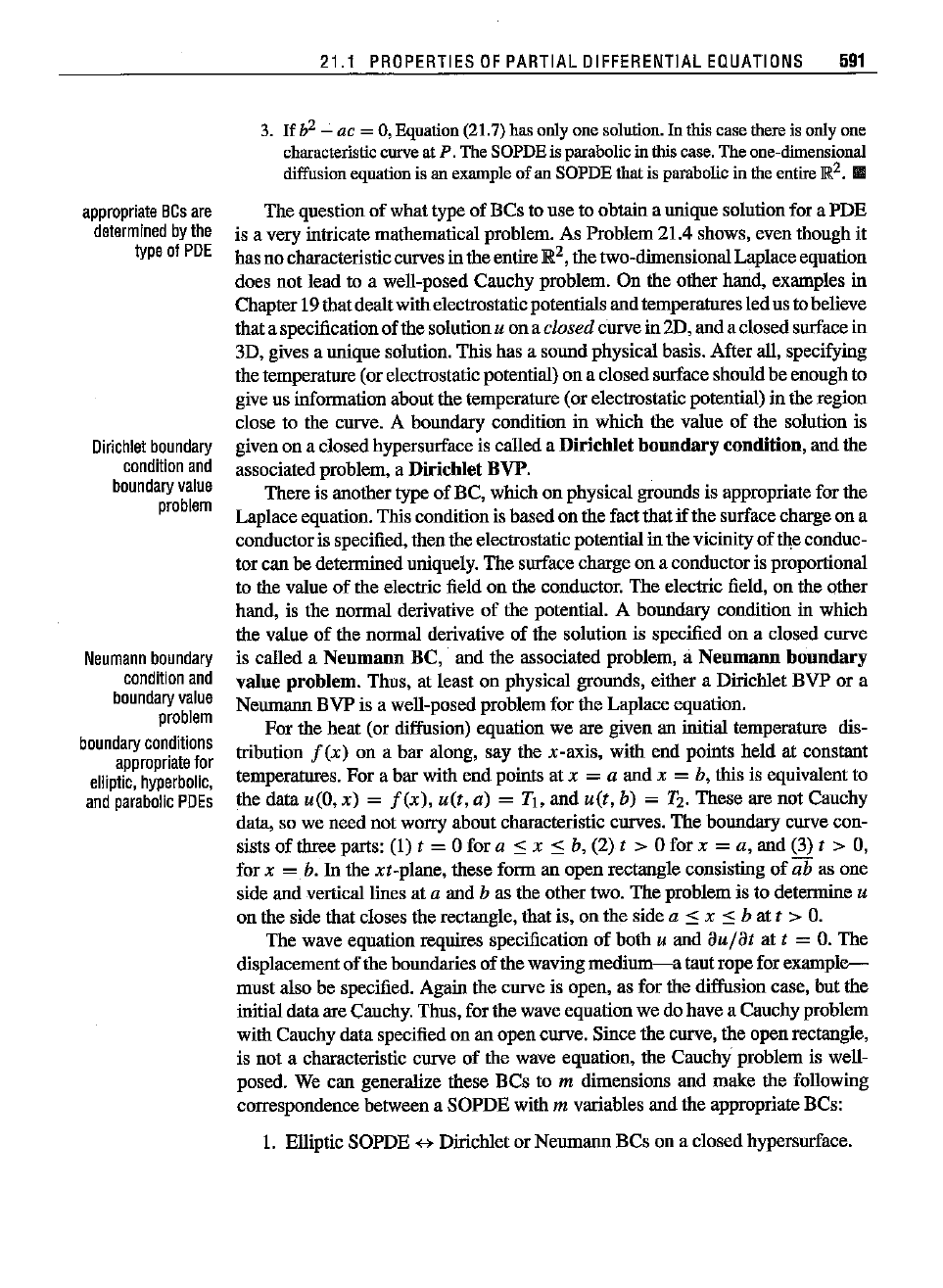
appropriate
BGs
are
determined
bythe
type
of
POE
Oirichlet
boundary
condition
and
boundary
value
problem
Neumann
boundary
condition
and
boundary
value
problem
boundary
conditions
appropriate
for
elliptic,
hyperbolic,
and
parabolic
POEs
21.1
PROPERTIES
OF
PARTIAL
OIFFERENTIAL
EQUATIONS
591
3.
If
b
2
- ac = 0, Equation(21.7) has only
one
solution. In this case there is only one
characteristic curve at
P.
The
SOPDE
is parabolic in this case. The one-dimensional
diffusion equation is an example of an SOPDE that is parabolic in the entire
IR
Z.
IlIIII
The question
of
what type of BCs to use to obtain a unique solution for a PDE
is a very intricate mathematicalproblem. As Problem 21.4 shows, even though it
has no characteristiccurves in the entire
R'",
the two-dimensionalLaplace eqnation
does not lead to a well-posed Cauchy problem.
On the other hand, examples in
Chapter19that dealtwith electrostaticpotentials and temperaturesled us to believe
that a specificationof the solution
u on aclosedcurvein 2D, and a closed surface in
3D, gives a unique solution. This has a sound physical basis. After all, specifying
the temperature (or electrostaticpotential) on a closedsurface shouldbe enoughto
give us information about the temperature (or electrostatic potential) in the region
close to the curve. A boundary condition in which the value
of
the solution is
given on a closedhypersurface is called a
Dirichlet
boundary
condition, and the
associated problem, a
Dirichlet
HVP.
There is another type of BC, which on physical grounds is appropriate for the
Laplaceequation. This condition is basedon the fact that
if
the surface charge on a
conductoris specified, then the electrostatic potentialin the vicinity
of
the conduc-
tor can be determined uniquely. The surface charge on a conductor is proportional
to the value
of
the electric field on the conductor. The electric field, on the other
hand, is the normal derivative
of
the potential. A boundary condition in which
the value
of
the normal derivative of the solution is specified on a closed curve
is called a
Neumann
BC,
and the associated problem, a
Neumann
bonndary
value
problem.
Thus, at least on physical grounds, either a Dirichlet
BVP
or a
Neumann BVP is a well-posed problem for the Laplace equation.
For the heat (or diffusion) equation we are given an initial temperature dis-
tribution
f(x)
on a bar along, say the x-axis, with end points held at constant
temperatures.
For
a bar with end points at x = a and x = b, this is equivalent to
the data
u(O,x) =
f(x),
uit
;a) = Tj, and
u(t,
b) = h These are not Cauchy
data, so we neednot worry about characteristic curves. The boundary curve con-
sists
of
three parts:
(I)
t = 0 for a
:s:
x
:s:
b, (2) t > 0 for x = a, and (3) t > 0,
for
x = b.
In
the xt-plane, these form an open rectangle consisting
of
ab as one
side and vertical lines at
a and b as the other two. The problem is to determine u
on the side that closes the rectangle, that is, on the side a
:s:
x
:s:
b at t >
O.
The wave equation reqnires specification of both u and
au/at
at t =
O.
The
displacement of the boundaries of the waving
medium-a
taut ropefor
example-
must also be specified. Again the curve is open, as for the diffusion case, but the
initial data are Cauchy. Thus, for the wave equation we do have a Cauchy problem
with Cauchy data specified on an opencurve. Since the curve, the open rectangle,
is not a characteristic curve of the wave equation, the Cauchy problem is well-
posed. We can generalize these
BCs
to m dimensions and make the following
correspondence between a SOPDE with
m variables and the appropriate BCs:
I.
Elliptic SOPDE +> Dirichlet or Neumann BCs on a closed hypersurface.
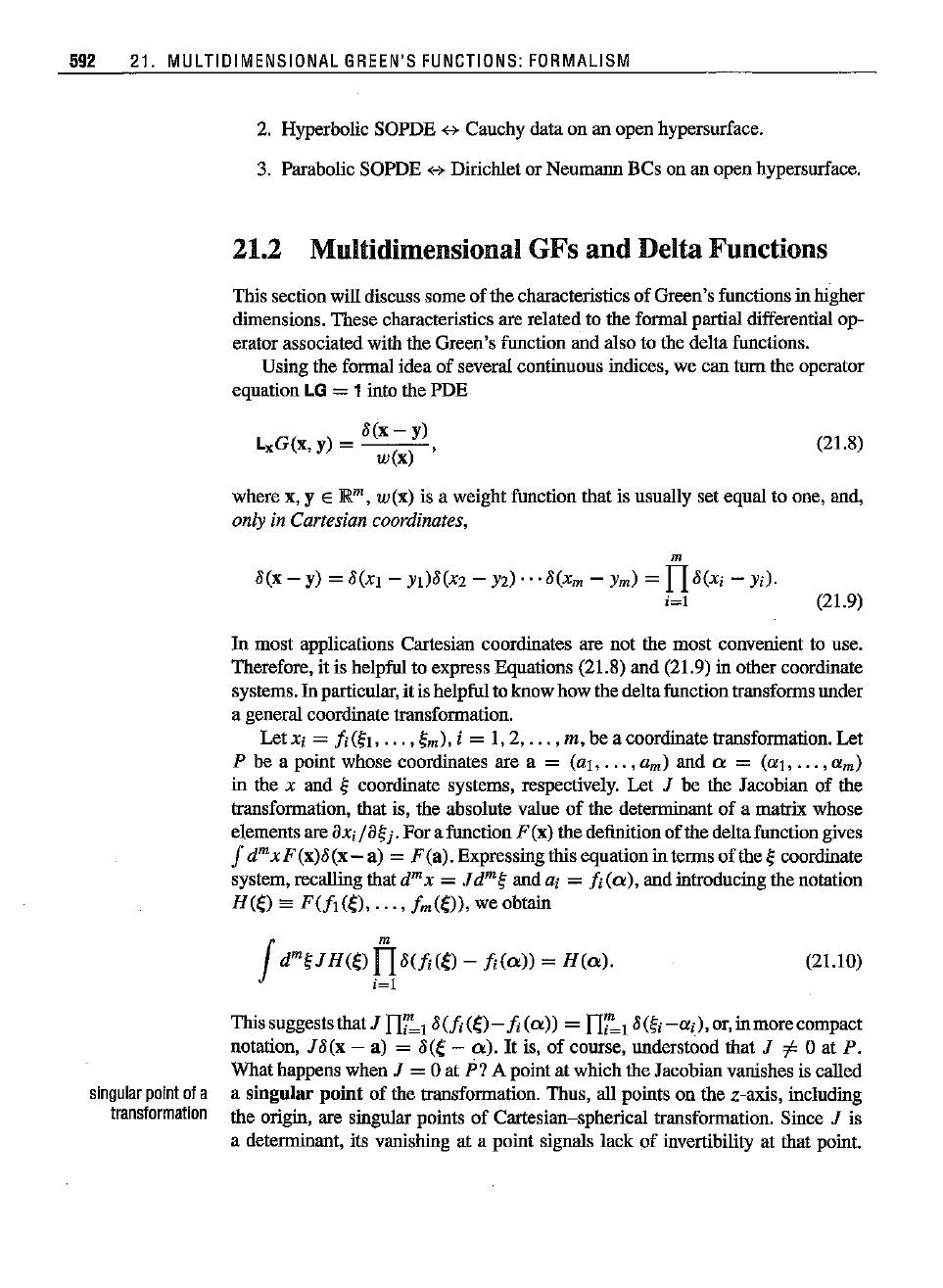
592 21. MULTIDIMENSIONAL
GREEN'S
FUNCTIONS:
FORMALISM
2. Hyperbolic SOPDE <+Cauchy dataon an open hypersurface.
3. Parabolic SOPDE <+Dirichlet or Neumann BCs on an openhypersurface.
21.2 Multidimensional GFs and Delta Functions
This section will discuss some
of
the characteristics
of
Green's functions in higher
dimensions. These characteristics are related to the formal partial differential op-
erator associated with the Green's function and also to the delta functions.
Using the formal idea
of
several continuous indices, we can
tum
the operator
equation
LG = 1 into the
PDE
8(x
- y)
LxG(x,
y) =
w(x)
,
(21.8)
where x, y E
jRm,
w(x)
is a weight function that is usually set equal to one, and,
onlyin
Cartesian
coordinates,
m
8(x
- y) =
8(xl
- YI)8(xz - yz)
...
8(x
m
-
Ym)
=
T18(Xi
- Yd·
i=l
(21.9)
(21.10)
In
most applications Cartesian coordinates are not the
most
convenient to use.
Therefore, it is helpful to express Equations
(21.8) and (21.9) in other coordinate
syslems.
In particular, it is helpfulto knowhow the deltafunction transformsunder
a general coordinate transformation.
Let
Xi =
fi(l;l,
...
,I;m),i =
1,2,
...
, m, he a coordinate transformation. Let
P he a point whose coordinates are a =
(al,
...
,am) and a =
(al,
...
,am)
in the x and I; coordinate systems, respectively. Let J be the Jacobian
of
the
transformation, that is, the absolute value
of
the determinant
of
a matrix whose
elementsare
axil
al;i-
For
a function F (x) the definition
of
the deltafunction gives
Jd
mxF(x)8(x-a)
=
F(a).Expressingthisequationintermsofthel;
coordinate
system, recalling that
dmx =Jdml; and a: =
fiCa),
and introducing the notation
H(e)
==
F(fl(e),
...
, fm(e)), we obtain
f
dmUH(e)
fI
8(!i(e)
-
!i(a))
=
H(a).
i=l
This suggeststhat J
f17'~18(!i(e)-
!i(a))
=
f17'~18(l;i-ai),or,inmorecompact
notation,
J8(x
- a) = 8(e -
a).
It
is,
of
course, understood that J
f=
0 at P.
Whathappens when J = 0 at P? A point at whichthe Jacobian vanishes is called
singular
point
ofa a
singular
point
of
the transformation. Thus, all points on the z-axis, including
!ranstorma!ion
the origin, are singular points
of
Cartesian-spherical transformation. Since J is
a determinant, its vanishing at a point signals
lack
of
invertibility at that point.
